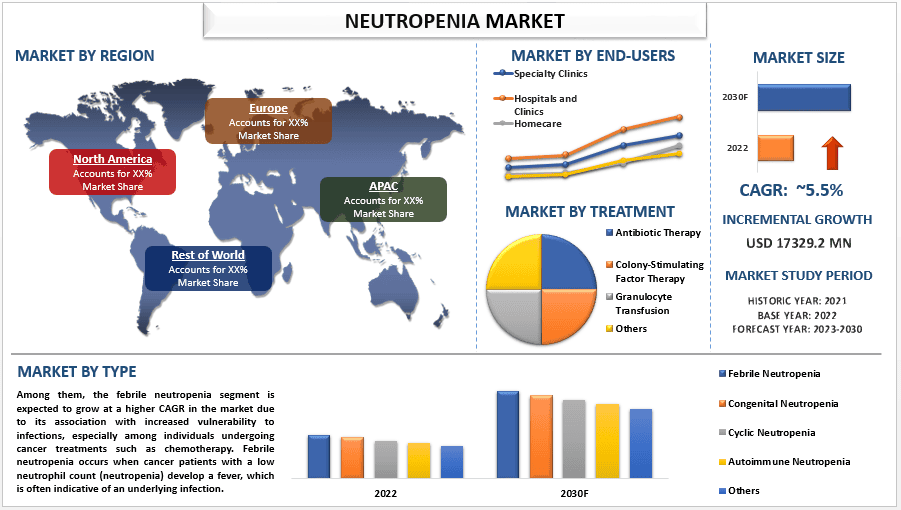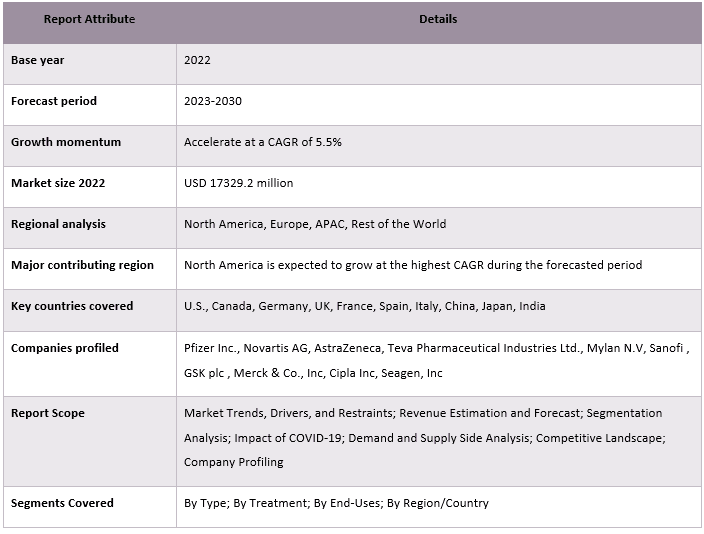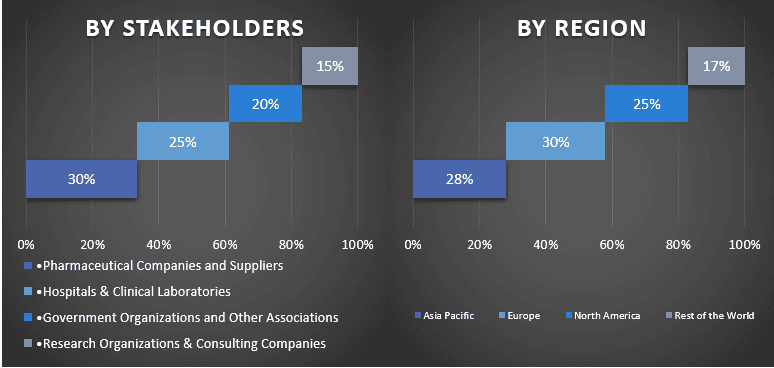- Trang chủ
- Về chúng tôi
- Ngành
- Dịch vụ
- Đọc
- Liên hệ với chúng tôi
Thị trường giảm bạch cầu trung tính: Phân tích hiện tại và Dự báo (2023-2030)
Nhấn mạnh vào Loại (Giảm bạch cầu trung tính bẩm sinh, Giảm bạch cầu trung tính do sốt, Giảm bạch cầu trung tính tuần hoàn, Giảm bạch cầu trung tính tự miễn, Loại khác); Điều trị (Liệu pháp kháng sinh, Liệu pháp yếu tố kích thích tạo khuẩn lạc, Truyền bạch cầu hạt, Loại khác); Người dùng cuối (Bệnh viện, Chăm sóc tại nhà, Trung tâm chuyên khoa, Loại khác); và Khu vực/Quốc gia

Thị trường giảm bạch cầu trung tính được định giá 17329,2 triệu USD vào năm 2022 và dự kiến sẽ tăng trưởng với tốc độ CAGR là 5,5% từ năm 2023-2030. Giảm bạch cầu trung tính là một tình trạng bệnh lý đặc trưng bởi số lượng bạch cầu trung tính thấp; một loại tế bào bạch cầu cần thiết cho hệ thống miễn dịch. Giảm bạch cầu trung tính có thể là kết quả của nhiều nguyên nhân khác nhau, bao gồm hóa trị, một số loại thuốc hoặc các bệnh lý tiềm ẩn. Thị trường bao gồm các can thiệp dược phẩm, phương pháp điều trị, công cụ chẩn đoán và chăm sóc hỗ trợ nhằm giải quyết tình trạng giảm bạch cầu trung tính và cải thiện kết quả cho bệnh nhân. Sự gia tăng tỷ lệ mắc bệnh giảm bạch cầu trung tính do điều trị ung thư, đặc biệt là hóa trị, đang thúc đẩy thị trường giảm bạch cầu trung tính. Bệnh nhân ung thư thường bị giảm bạch cầu trung tính như một tác dụng phụ, làm tăng nhu cầu can thiệp điều trị để kiểm soát và ngăn ngừa các biến chứng liên quan. Ví dụ, theo PAHO, năm 2023, trên toàn cầu, ước tính có 20 triệu ca ung thư mới và 10 triệu ca tử vong do ung thư. Gánh nặng ung thư sẽ tăng khoảng 60% trong hai thập kỷ tới, gây thêm căng thẳng cho hệ thống y tế, người dân và cộng đồng.
Một số công ty lớn hoạt động trên thị trường bao gồm Pfizer Inc., Novartis AG, AstraZeneca, Teva Pharmaceutical Industries Ltd., Mylan N.V, Sanofi , GSK plc , Merck & Co., Inc, Cipla Inc, Seagen, Inc. Một số hoạt động M&A cùng với các quan hệ đối tác đã được thực hiện bởi những công ty này để tạo điều kiện cho khách hàng tiếp cận các sản phẩm/công nghệ công nghệ cao và tiên tiến.
Thông tin chi tiết được trình bày trong báo cáo
“Trong số các loại, phân khúc giảm bạch cầu trung tính do sốt chiếm thị phần đáng kể trên thị trường vào năm 2023.”
Dựa trên loại, thị trường được phân loại thành giảm bạch cầu trung tính bẩm sinh, giảm bạch cầu trung tính do sốt, giảm bạch cầu trung tính tuần hoàn, giảm bạch cầu trung tính tự miễn và các loại khác. Trong số đó, phân khúc giảm bạch cầu trung tính do sốt dự kiến sẽ tăng trưởng với tốc độ CAGR cao hơn trên thị trường do liên quan đến việc tăng khả năng dễ bị nhiễm trùng, đặc biệt là ở những người đang điều trị ung thư như hóa trị. Giảm bạch cầu trung tính do sốt xảy ra khi bệnh nhân ung thư có số lượng bạch cầu trung tính thấp (giảm bạch cầu trung tính) bị sốt, thường là dấu hiệu của nhiễm trùng tiềm ẩn. Giảm bạch cầu trung tính do sốt gây ra nguy cơ nhiễm trùng nghiêm trọng đáng kể và nếu không được quản lý kịp thời và hiệu quả, có thể dẫn đến các biến chứng đe dọa tính mạng.
“Trong số các phương pháp điều trị, phân khúc liệu pháp yếu tố kích thích khuẩn lạc có tốc độ CAGR cao hơn trên thị trường vào năm 2023.”
Dựa trên phương pháp điều trị, thị trường được phân loại thành liệu pháp kháng sinh, liệu pháp yếu tố kích thích khuẩn lạc, truyền bạch cầu hạt và các phương pháp khác. Trong số đó, phân khúc liệu pháp yếu tố kích thích khuẩn lạc dự kiến sẽ tăng trưởng với tốc độ CAGR cao hơn trên thị trường. Phân khúc liệu pháp yếu tố kích thích khuẩn lạc (CSF) rất quan trọng trong thị trường Giảm bạch cầu trung tính vì nó đóng vai trò chính trong việc quản lý giảm bạch cầu trung tính, đặc biệt trong các trường hợp tình trạng này do hóa trị hoặc các phương pháp điều trị y tế khác gây ra. Giảm bạch cầu trung tính thường là tác dụng phụ của điều trị ung thư và liệu pháp CSF giúp kích thích sản xuất bạch cầu trung tính, một loại tế bào bạch cầu, để giảm nguy cơ nhiễm trùng. Phân khúc này đã chứng kiến sự tăng trưởng do sự gia tăng tỷ lệ giảm bạch cầu trung tính do hóa trị và nhu cầu chăm sóc hỗ trợ hiệu quả.
“Bắc Mỹ thống trị thị trường giảm bạch cầu trung tính vào năm 2023.”
Thị trường giảm bạch cầu trung tính ở Bắc Mỹ dự kiến sẽ tiếp tục tăng trưởng trong những năm tới, được thúc đẩy bởi sự gia tăng tỷ lệ mắc bệnh ung thư và sự nâng cao nhận thức về giảm bạch cầu trung tính trong giới chuyên gia chăm sóc sức khỏe và dân chúng, sự phát triển của các kỹ thuật hình ảnh tiên tiến và sự gia tăng các lựa chọn điều trị. Ví dụ, vào năm 2020, theo Hiệp hội Ung thư Hoa Kỳ, ung thư là nguyên nhân gây tử vong phổ biến thứ hai ở Hoa Kỳ, chỉ sau bệnh tim. Khoảng 609.360 ca tử vong do ung thư dự kiến ở Hoa Kỳ vào năm 2022, tương đương khoảng 1.670 ca tử vong mỗi ngày.
Phạm vi Báo cáo Thị trường Giảm bạch cầu trung tính

Lý do nên mua báo cáo này:
- Nghiên cứu bao gồm phân tích định cỡ và dự báo thị trường được xác thực bởi các chuyên gia hàng đầu trong ngành.
- Báo cáo trình bày một đánh giá nhanh về hiệu suất tổng thể của ngành trong nháy mắt.
- Báo cáo bao gồm phân tích chuyên sâu về các đối thủ cạnh tranh nổi bật trong ngành với trọng tâm chính là tình hình tài chính kinh doanh, danh mục sản phẩm, chiến lược mở rộng và những phát triển gần đây.
- Kiểm tra chi tiết các yếu tố thúc đẩy, hạn chế, xu hướng chính và cơ hội hiện hành trong ngành.
- Nghiên cứu bao gồm toàn diện thị trường trên các phân khúc khác nhau.
- Phân tích sâu cấp khu vực của ngành.
Tùy chọn tùy chỉnh:
Thị trường Giảm bạch cầu trung tính toàn cầu có thể được tùy chỉnh thêm theo yêu cầu hoặc bất kỳ phân khúc thị trường nào khác. Bên cạnh đó, UMI hiểu rằng bạn có thể có nhu cầu kinh doanh riêng, do đó, hãy thoải mái liên hệ với chúng tôi để nhận báo cáo hoàn toàn phù hợp với yêu cầu của bạn.
Mục lục
Phương Pháp Nghiên Cứu Phân Tích Thị Trường Giảm Bạch Cầu Trung Tính (2022-2030)
Phân tích thị trường lịch sử, ước tính thị trường hiện tại và dự báo thị trường tương lai của thị trường Giảm Bạch Cầu Trung Tính toàn cầu là ba bước chính được thực hiện để tạo và phân tích việc áp dụng Giảm Bạch Cầu Trung Tính ở các khu vực lớn trên toàn cầu. Nghiên cứu thứ cấp chuyên sâu đã được thực hiện để thu thập các số liệu thị trường lịch sử và ước tính quy mô thị trường hiện tại. Thứ hai, để xác thực những hiểu biết sâu sắc này, nhiều phát hiện và giả định đã được xem xét. Hơn nữa, các cuộc phỏng vấn sơ cấp chuyên sâu cũng đã được thực hiện với các chuyên gia trong ngành trên toàn bộ chuỗi giá trị của thị trường Giảm Bạch Cầu Trung Tính toàn cầu. Sau khi giả định và xác thực số liệu thị trường thông qua các cuộc phỏng vấn sơ cấp, chúng tôi đã sử dụng phương pháp tiếp cận từ trên xuống/từ dưới lên để dự báo quy mô thị trường hoàn chỉnh. Sau đó, các phương pháp phân tích dữ liệu chi tiết và tam giác hóa dữ liệu đã được áp dụng để ước tính và phân tích quy mô thị trường của các phân khúc và phân khúc phụ liên quan đến ngành. Phương pháp luận chi tiết được giải thích dưới đây:
Phân Tích Quy Mô Thị Trường Lịch Sử
Bước 1: Nghiên Cứu Chuyên Sâu Các Nguồn Thứ Cấp:
Nghiên cứu thứ cấp chi tiết đã được thực hiện để thu thập quy mô thị trường lịch sử của thị trường Giảm Bạch Cầu Trung Tính thông qua các nguồn nội bộ của công ty như báo cáo thường niên & báo cáo tài chính, thuyết trình hiệu suất, thông cáo báo chí, v.v., và các nguồn bên ngoài bao gồm tạp chí, tin tức & bài viết, ấn phẩm của chính phủ, ấn phẩm của đối thủ cạnh tranh, báo cáo ngành, cơ sở dữ liệu của bên thứ ba và các ấn phẩm đáng tin cậy khác.
Bước 2: Phân Khúc Thị Trường:
Sau khi thu được quy mô thị trường lịch sử của thị trường Giảm Bạch Cầu Trung Tính, chúng tôi đã tiến hành phân tích thứ cấp chi tiết để thu thập thông tin chi tiết về thị trường lịch sử và chia sẻ cho các phân khúc & phân khúc phụ khác nhau cho các khu vực lớn. Các phân khúc chính được bao gồm trong báo cáo là loại, phương pháp điều trị và người dùng cuối. Phân tích cấp quốc gia sâu hơn đã được thực hiện để đánh giá việc áp dụng tổng thể các mô hình thử nghiệm ở khu vực đó.
Bước 3: Phân Tích Yếu Tố:
Sau khi thu được quy mô thị trường lịch sử của các phân khúc và phân khúc phụ khác nhau, chúng tôi đã tiến hành phân tích yếu tố chi tiết để ước tính quy mô thị trường hiện tại của thị trường Giảm Bạch Cầu Trung Tính. Hơn nữa, chúng tôi đã tiến hành phân tích yếu tố bằng cách sử dụng các biến phụ thuộc và độc lập như loại, phương pháp điều trị và người dùng cuối của thị trường Giảm Bạch Cầu Trung Tính. Một phân tích kỹ lưỡng đã được thực hiện cho các kịch bản cung và cầu, xem xét các quan hệ đối tác hàng đầu, sáp nhập và mua lại, mở rộng kinh doanh và ra mắt sản phẩm trong lĩnh vực thị trường Giảm Bạch Cầu Trung Tính trên toàn cầu.
Ước Tính & Dự Báo Quy Mô Thị Trường Hiện Tại
Định Cỡ Thị Trường Hiện Tại: Dựa trên những hiểu biết sâu sắc có thể hành động từ 3 bước trên, chúng tôi đã xác định quy mô thị trường hiện tại, những người chơi chính trong thị trường Giảm Bạch Cầu Trung Tính toàn cầu và thị phần của các phân khúc. Tất cả các phần trăm chia sẻ bắt buộc và phân tích thị trường đã được xác định bằng cách sử dụng phương pháp thứ cấp đã đề cập ở trên và đã được xác minh thông qua các cuộc phỏng vấn sơ cấp.
Ước Tính & Dự Báo: Để ước tính và dự báo thị trường, trọng số đã được gán cho các yếu tố khác nhau bao gồm các yếu tố thúc đẩy & xu hướng, hạn chế và cơ hội dành cho các bên liên quan. Sau khi phân tích các yếu tố này, các kỹ thuật dự báo có liên quan, tức là phương pháp tiếp cận từ trên xuống/từ dưới lên đã được áp dụng để đưa ra dự báo thị trường cho năm 2030 cho các phân khúc và phân khúc phụ khác nhau trên các thị trường lớn trên toàn cầu. Phương pháp nghiên cứu được áp dụng để ước tính quy mô thị trường bao gồm:
- Quy mô thị trường của ngành, về doanh thu (USD) và tỷ lệ áp dụng thị trường Giảm Bạch Cầu Trung Tính trên các thị trường lớn trong nước
- Tất cả các phần trăm chia sẻ, phân tách và phân tích các phân khúc và phân khúc phụ của thị trường
- Những người chơi chính trong thị trường Giảm Bạch Cầu Trung Tính toàn cầu về các sản phẩm được cung cấp. Ngoài ra, các chiến lược tăng trưởng được các đối thủ này áp dụng để cạnh tranh trên thị trường đang phát triển nhanh chóng
Xác Thực Quy Mô và Thị Phần Thị Trường
Nghiên Cứu Sơ Cấp: Các cuộc phỏng vấn chuyên sâu đã được thực hiện với các Nhà Lãnh Đạo Quan Điểm Chủ Chốt (KOL) bao gồm các Giám Đốc Điều Hành Cấp Cao (CXO/VP, Trưởng Phòng Kinh Doanh, Trưởng Phòng Marketing, Trưởng Phòng Vận Hành, Trưởng Phòng Khu Vực, Trưởng Phòng Quốc Gia, v.v.) trên khắp các khu vực lớn. Các phát hiện nghiên cứu sơ cấp sau đó đã được tóm tắt và phân tích thống kê đã được thực hiện để chứng minh giả thuyết đã nêu. Các đầu vào từ nghiên cứu sơ cấp đã được hợp nhất với các phát hiện thứ cấp, do đó biến thông tin thành những hiểu biết sâu sắc có thể hành động.
Phân Chia Người Tham Gia Sơ Cấp Ở Các Khu Vực Khác Nhau

Kỹ Thuật Thị Trường
Kỹ thuật tam giác hóa dữ liệu đã được sử dụng để hoàn thành việc ước tính thị trường tổng thể và đưa ra các số liệu thống kê chính xác cho từng phân khúc và phân khúc phụ của thị trường Giảm Bạch Cầu Trung Tính toàn cầu. Dữ liệu được chia thành một số phân khúc & phân khúc phụ sau khi nghiên cứu các thông số và xu hướng khác nhau trong các lĩnh vực loại, phương pháp điều trị và người dùng cuối trong thị trường Giảm Bạch Cầu Trung Tính toàn cầu.
Mục tiêu chính của Nghiên Cứu Thị Trường Giảm Bạch Cầu Trung Tính Toàn Cầu
Các xu hướng thị trường hiện tại & tương lai của thị trường Giảm Bạch Cầu Trung Tính toàn cầu đã được xác định rõ trong nghiên cứu. Các nhà đầu tư có thể thu được những hiểu biết sâu sắc chiến lược để làm cơ sở cho quyết định đầu tư của họ dựa trên phân tích định tính và định lượng được thực hiện trong nghiên cứu. Các xu hướng thị trường hiện tại và tương lai xác định sự hấp dẫn tổng thể của thị trường ở cấp khu vực, cung cấp một nền tảng cho người tham gia công nghiệp khai thác thị trường chưa được khai thác để hưởng lợi từ lợi thế của người đi đầu. Các mục tiêu định lượng khác của các nghiên cứu bao gồm:
- Phân tích quy mô thị trường hiện tại và dự báo của thị trường Giảm Bạch Cầu Trung Tính về giá trị (USD). Ngoài ra, hãy phân tích quy mô thị trường hiện tại và dự báo của các phân khúc và phân khúc phụ khác nhau
- Các phân khúc trong nghiên cứu bao gồm các lĩnh vực loại, phương pháp điều trị và người dùng cuối
- Xác định và phân tích khung pháp lý cho ngành Giảm Bạch Cầu Trung Tính
- Phân tích chuỗi giá trị liên quan đến sự hiện diện của các trung gian khác nhau, cùng với việc phân tích hành vi của khách hàng và đối thủ cạnh tranh trong ngành
- Phân tích quy mô thị trường hiện tại và dự báo của thị trường Giảm Bạch Cầu Trung Tính cho khu vực chính
- Các quốc gia lớn trong khu vực được nghiên cứu trong báo cáo bao gồm Châu Á Thái Bình Dương, Châu Âu, Bắc Mỹ và Phần còn lại của Thế giới
- Hồ sơ công ty của thị trường Giảm Bạch Cầu Trung Tính và các chiến lược tăng trưởng được các đối thủ trên thị trường áp dụng để duy trì trên thị trường đang phát triển nhanh chóng
- Phân tích chuyên sâu cấp khu vực của ngành
Câu hỏi thường gặp Câu hỏi thường gặp
H1: Kích thước thị trường hiện tại và tiềm năng tăng trưởng của thị trường Giảm bạch cầu trung tính toàn cầu là gì?
Q2: Đâu là những yếu tố thúc đẩy sự tăng trưởng của thị trường giảm bạch cầu trung tính toàn cầu?
Q3: Phân khúc nào sẽ là phân khúc phát triển nhanh nhất của thị trường Neutropenia toàn cầu theo Loại?
Q4: Các công nghệ và xu hướng mới nổi trong thị trường giảm bạch cầu trung tính toàn cầu là gì?
Câu hỏi 5: Khu vực nào sẽ chiếm ưu thế trên thị trường Giảm bạch cầu trung tính toàn cầu?
Q6: Ai là những công ty chủ chốt hoạt động trên thị trường giảm bạch cầu trung tính toàn cầu?
Liên quan Báo cáo
Khách hàng đã mua mặt hàng này cũng đã mua










